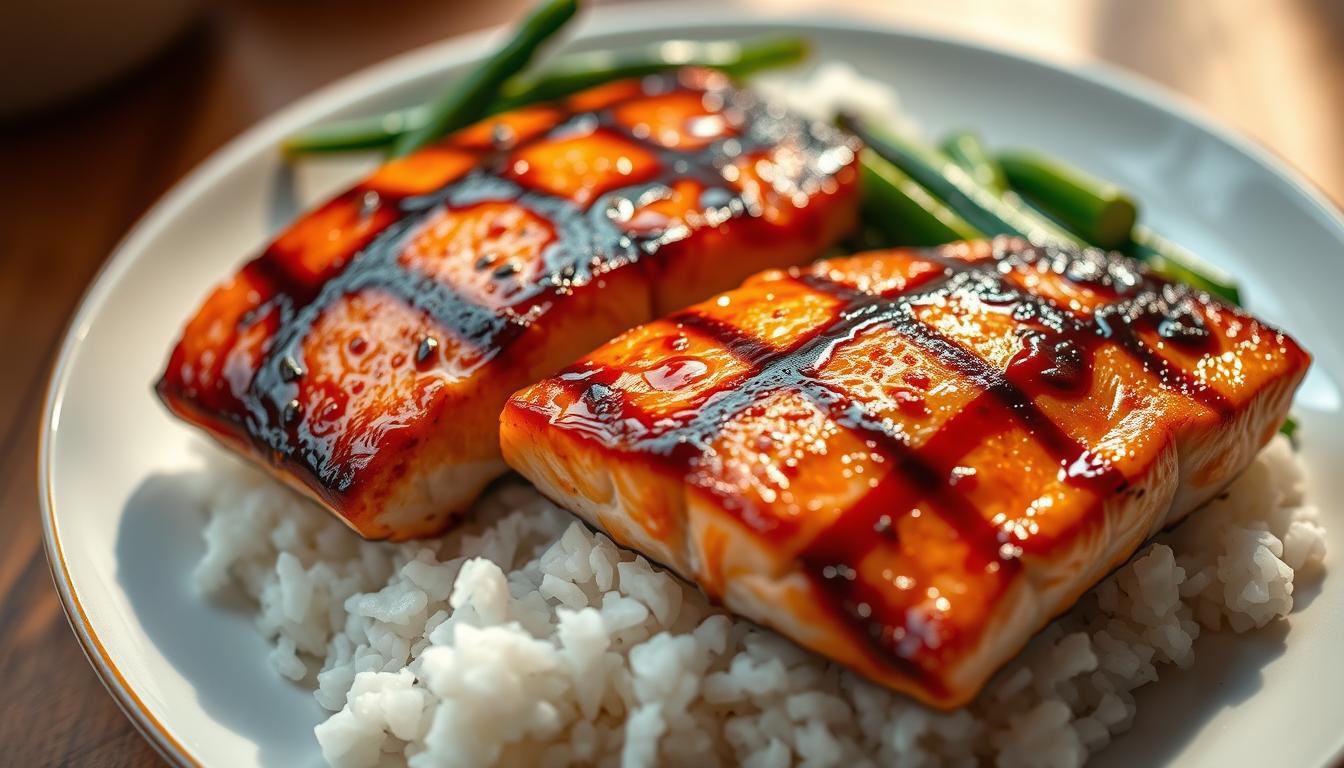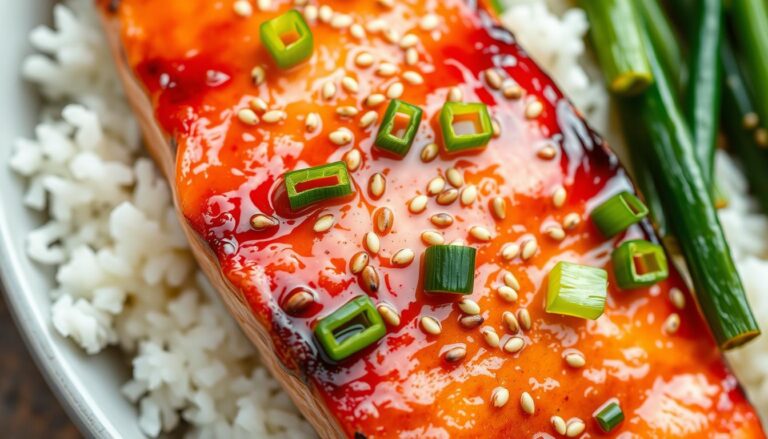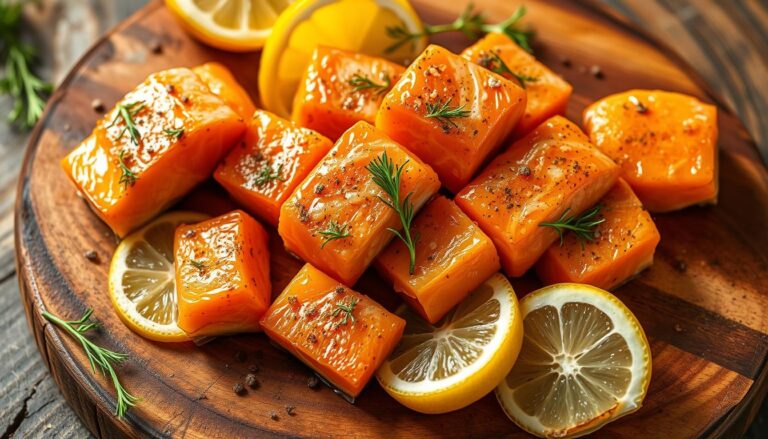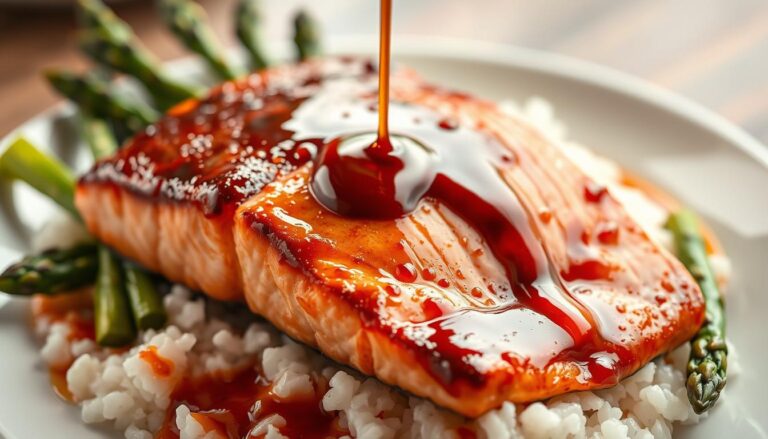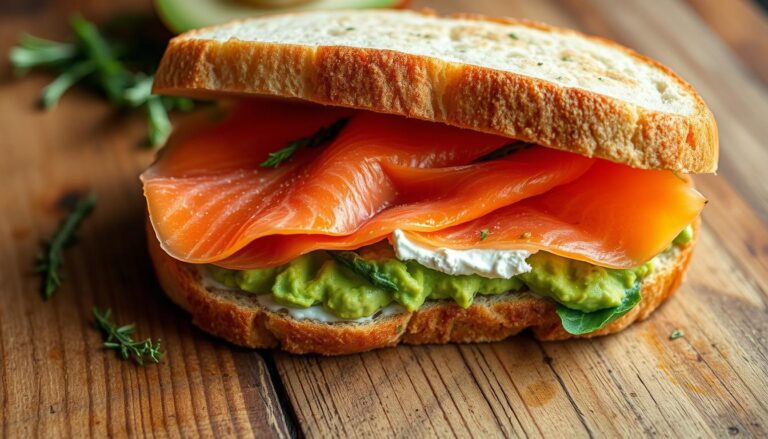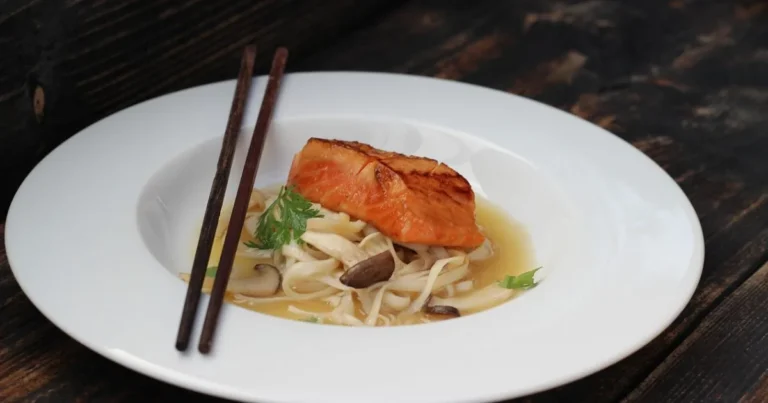Salmon and Teriyaki: Flavorful Fusion
You know the comfort of a weeknight meal that feels special without drama. This recipe brings a sticky-sweet glaze, bright ginger notes, and a flaky fillet to your table in about 20–30 minutes.
You’ll learn a quick, reliable method using a simple homemade teriyaki sauce made from soy, ginger, garlic, brown sugar, sesame oil, and rice wine vinegar.
The approach is flexible: bake at 400°F until the fish flakes, finish briefly under the broiler for a crisp top, or air fry for extra crunch. A short 20–30 minute marinade layers flavor without mushy texture.
Serve with rice, steamed broccoli, and edamame for a balanced dinner that highlights protein and clean flavors. Small tweaks let you tailor sweetness or tang, so this recipe becomes one you return to again and again.
Table of Contents
Why You’ll Love This Salmon and Teriyaki Recipe
A fast method yields flaky fillets with a glossy, flavorful finish.
Big flavor in little time: A short 20–30 minute marinade and a 12–18 minute bake at 400°F create tender, flaky fish and a sticky glaze. Finish under the broiler to caramelize the top for extra texture.
Fast weeknight win
You get a dinner-ready plate in under an hour of total time. Wild fish cooks closer to the low end of the minutes range. Farmed fillets hold more fat, so they’re forgiving if you run a touch long.
Balanced flavors
The homemade sauce blends sweet, tangy, salty, and savory notes. Reduce it on the stove for a glossy finish or whisk in a cornstarch slurry for an instant thickener. Adjust sugar, soy, and vinegar to fit your palate.
| Step | Temp | Time |
|---|---|---|
| Marinate | Room temp | 20–30 minutes |
| Bake | 400°F | 12–18 minutes |
| Broil (finish) | High | 1–2 minutes |
- Delivers protein and satisfying richness.
- Flexible: bake, pan-sear, or air fry to match your schedule.
Ingredients for Success: Salmon, Teriyaki Sauce, and Garnishes
Gather a short list of pantry staples and fresh items to build a balanced, flavorful dish.
Pick the right cut: choose fillets for a plated look or bite-size cubes for bowls. Wild fish cooks faster and is leaner; farmed pieces are thicker and more forgiving.
Homemade sauce staples
Whisk low-sodium soy sauce with grated ginger, minced garlic, and light brown sugar to make classic teriyaki sauce. Layer a splash of rice wine vinegar for brightness and a touch of sesame oil for nuttiness.
Optional add-ins and thickening
Reduce the mixture on the stove to concentrate flavor or stir in a cornstarch slurry (1 teaspoon cornstarch + 1 tablespoon cold water) to make a glossy sauce that will cling.
Finishing touches
- Garnish with sesame seeds and chopped scallions for crunch and color.
- Add a pinch of red pepper flakes for heat.
- Keep a small cup for quick measure; use water or oil to manage stickiness on the pan.
Prep Like a Pro: Marinating, Slicing, and Pan Readiness
Simple prep steps help the fish cook evenly and let the sauce shine without fuss.
Marinate smart: Pat the salmon dry, then slice fillets evenly so each piece cooks the same time. Use half the sauce to marinate for 20–30 minutes; longer acidic mixes can make the flesh mushy, so set a timer for the right minutes.
Skin decisions: Keep skin on whole fillets to lock in moisture and make lifting easy after baking. Remove skin when cutting into cubes if you want even browning on all sides; leaving skin adds richness.
- Portion the sauce: half to marinate, half reserved for glazing to stay food-safe.
- Lightly oil the pan or lined baking sheet to prevent sticking and ease cleanup.
- Pat pieces again before searing; use tongs or a fish spatula to handle gently.
- Make teriyaki ahead and chill so final prep moves fast on busy nights.
Step-by-Step: Baked Teriyaki Salmon in the Oven
Follow a few clear steps for a reliable, oven-ready result that locks in flavor without fuss.
Preheat and prep: Heat the oven to 400°F. Lightly oil a rimmed sheet pan so fillets release easily and cook in even heat. Arrange pieces with space between each one to let hot air circulate.
Bake time: Slide the pan into the oven and bake 12–18 minutes, depending on thickness. If you cut the fish into cubes, check at 10–14 minutes. Look for flesh that flakes with a fork and lifts cleanly from the skin.
Finish for texture: While the fish bakes, simmer the reserved teriyaki sauce in a small saucepan until glossy and slightly thickened. When the fillets are done, brush the hot top with sauce and broil 1–2 minutes to caramelize—watch closely to avoid burning.
- Rest the pieces a couple minutes so juices settle.
- Sprinkle chopped scallions and sesame seeds just before plating for color and crunch.
| Step | Oven Temp | Minutes |
|---|---|---|
| Preheat & arrange | 400°F | — |
| Bake fillets | 400°F | 12–18 minutes |
| Bake cubes | 400°F | 10–14 minutes |
| Broil to finish | High | 1–2 minutes |
Make the Sauce: From Simple Marinade to Glossy Glaze
Create a base you can split—one part to flavor the fish, one to cook into a shiny glaze.
Start by whisking low-sodium soy sauce with grated ginger, minced garlic, light brown sugar, a splash of rice wine vinegar, and a touch of sesame oil. Stir until the sugar dissolves so the mixture is smooth and even.
Stir, simmer, thicken
Divide the mix: keep half to marinate for 20–30 minutes and put the other half in a small saucepan. Reduce gently over low heat until it turns syrupy, or make a quick slurry—1 teaspoon cornstarch whisked with 1 tablespoon cold water—and stir it in until glossy.
Flavor control
Adjust sweetness with extra brown sugar or maple syrup. Dial back saltiness with a splash of water or choose tamari for a gluten-free option. Brighten the finish with more rice wine vinegar to taste.
- Simmer until the sauce coats the back of a spoon.
- Measure in tablespoons or a small cup to scale the recipe.
- Keep fresh ginger and garlic for vivid aromatics; dried versions work in a pinch.
Alternative Cooking Methods: Skillet, Air Fryer, and Frozen Options
Pick the method that fits your kitchen gear and the finish you want. Each route keeps the same flavor goals but shifts texture and time.
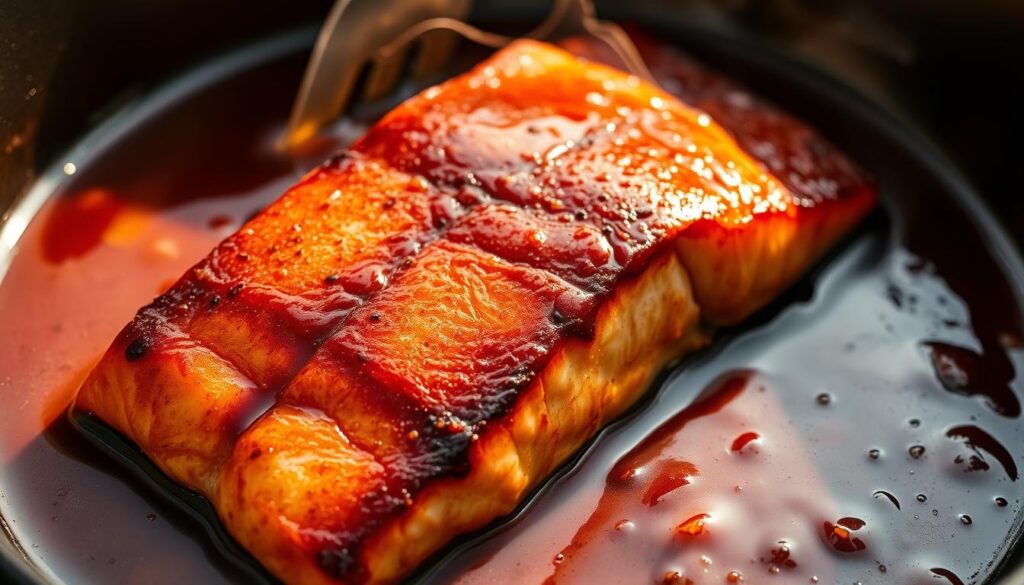
Pan-fried perfection: quick sear and glaze
Heat a lightly oiled pan over medium-high. Sear fillets 3–4 minutes per side to build a deep crust.
Warm the reserved sauce separately. Thicken with a little cornstarch, then brush on in the last minute for a glossy finish.
Air fryer convenience: crisp-tender bites
Preheat to 380°F. Arrange pieces in a single layer to avoid steaming.
Cubes take about 8–12 minutes; fillets need roughly 10–14 minutes, depending on thickness. This method gives crisp edges fast.
From frozen: add time and finish with extra sauce
When cooking from frozen, use the oven at 400°F and add 5–10 extra minutes. A quick sear after baking also helps if you want color.
Marinade won’t penetrate frozen flesh well, so save extra glaze to drizzle after cooking. Rest fish briefly before serving to keep it juicy.
- You’ll use the same doneness cues—flaky flesh and clean lift from the skin—across methods.
- Choose pan for crisp crust, air fryer for fast crispness, or oven for even, tender results.
salmon and teriyaki Serving Ideas
Make a composed bowl for easy meals that balance texture and bold flavor.
Build a bowl: rice, broccoli, edamame, scallions
Start with cilantro-lime rice as a warm base. Top with steamed broccoli, edamame, and sliced scallions.
Finish by spooning extra teriyaki sauce over the top so every bite stays glossy.
Grain swaps: quinoa or cauliflower rice
Swap the rice for quinoa if you want more protein. Use cauliflower rice for a grain-free, paleo-friendly side.
Leftover magic: salads and quick stir-fries
Flake cooked salmon over crisp greens for fast lunches. Toss pieces into a quick veggie stir-fry for another dinner in minutes.
“Keep a small cup of glaze on the plate so rice, fish, and veggies all get a hit of flavor.”
- Build satisfying bowls with rice, steamed broccoli, edamame, and scallions, then spoon extra sauce over the top.
- Swap grains with quinoa or cauliflower rice to match your goals without losing texture.
- Turn leftovers into speedy lunches: flake fish over salads or toss with veggies in a quick stir-fry.
- Pair with simple sides like roasted veggies or a sesame-dressed slaw for balance.
- Sprinkle sesame seeds and a pinch of red pepper flakes for crunch and gentle heat.
- Keep a little sauce for the plate so every bite of rice and fish gets that sweet-savory gloss.
- Use the glaze on chicken or tofu to make easy, unified meals for the week.
- Garnish to taste—more scallions for freshness or a squeeze of citrus for brightness.
Timing, Doneness, and Heat: Get It Just Right
Know your fish: fat content guides how long you should cook it.
Wild versus farmed matters because fat affects tolerance for heat. Wild cuts cook faster and benefit from the low end of the range. Farmed (higher fat) allows a few extra minutes without drying out.
Bake at 400°F for 12–18 minutes as a reliable baseline. Thicker salmon fillets need more minutes; thinner pieces finish sooner. Finish briefly under the broiler to crisp the top without overcooking the center.
Doneness cues are your best tool. Gently nudge the flesh with a fork—the fish should flake easily and lift clean from the skin. For cubes, look for even color through the center as a quick visual check.
Remember carryover cooking: pull pieces just shy of fully opaque. Keep the teriyaki sauce warm separately so you can glaze immediately for maximum shine and taste. If the glaze is soy-forward, balance salinity with a splash of water or milder sides.
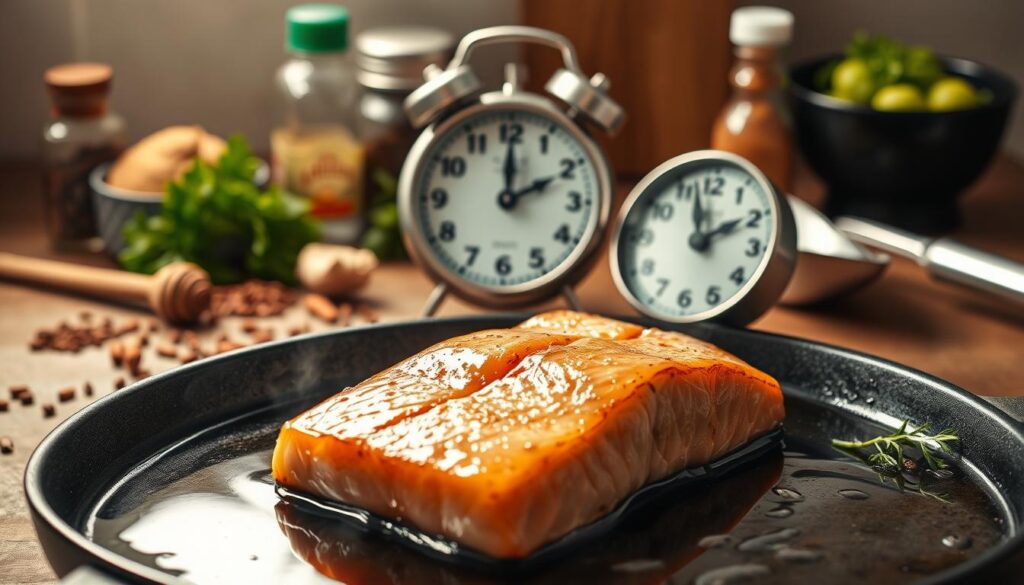
| Factor | Indicator | Tip |
|---|---|---|
| Fat level | Wild (lean) vs. farmed (fatty) | Lean fish → lower minutes; fatty → a few extra minutes |
| Oven standard | Temp 400°F | Bake 12–18 minutes, then broil 1–2 minutes to finish |
| Doneness check | Flakes and releases from skin | Pull just before fully opaque to allow carryover cooking |
| Cubes | Even color through center | Use as a fast weeknight visual cue |
Nutritional Notes and Smart Substitutions
Small swaps in the sauce deliver big wins for health without losing flavor.
Protein and healthy fats: Your fillet provides a high-quality protein source and heart-friendly fat. These support satiety and essential omega intake while keeping plates balanced.
Sodium and sugar awareness: Use low-sodium soy sauce or tamari to cut salt. Balance sweetness with brown sugar or maple syrup to taste, and measure sauce portions so sugar stays in check.
“Thin an overly salty glaze with a splash of water or serve it over plain rice to tame strong flavors.”
- Keep the glaze versatile: the same sauce works well on chicken or roasted vegetables for quick weeknight recipes.
- Swap regular soy for tamari and check labels on vinegars to keep dishes gluten-free.
- Pair with steamed veggies to add vitamins and fiber, and track sauce portions to manage fat and sodium.
Storage, Reheating, and Make-Ahead Tips
A little care in storage and reheating keeps your meal restaurant-quality at home.
Cool fully before storing. Let cooked fish reach room temperature, then pack in airtight containers. Refrigerate for up to 2 days for best quality and food safety.
Best refrigeration practices
Use shallow containers to cool faster. Label with the date so you track freshness.
How to reheat without drying
Reheat low and slow in the oven or in a covered pan over gentle heat. Add a spoonful of water to the pan to create steam and preserve moisture.
Avoid high-power microwaving when possible. If you must use the microwave, heat in short bursts and cover to retain water and texture.
Make-ahead sauce and prep
Store extra sauce chilled and warm it separately. Drizzle warmed sauce over the reheated fish to restore gloss and flavor.
- Lightly oil the pan or line a tray to prevent sticking during reheats.
- Label containers with date and contents to keep your recipes organized.
- If the fish started frozen, expect less sauce penetration; add fresh glaze after reheating.
| Step | Tip | Why |
|---|---|---|
| Cool first | Shallow containers | Faster cooling, safer storage |
| Reheat | Oven or covered pan, low heat | Preserves texture, avoids drying |
| Sauce | Warm separately | Restores shine and flavor |
Conclusion
Let clear time markers and a warm sauce bring consistent results to your weeknight plate.
Trust the template: marinate 20–30 minutes, bake at 400°F for 12–18 minutes (or air fry / pan-sear per your gear), then broil briefly to caramelize the top. Use low-sodium soy or tamari and thicken by reduction or a cornstarch slurry for a glossy glaze.
Finish with sesame and chopped scallions, serve over rice with simple veggies, and store leftovers up to 2 days. With these steps you’ll repeat this teriyaki salmon recipe with confidence and tweak time and heat as you go.

